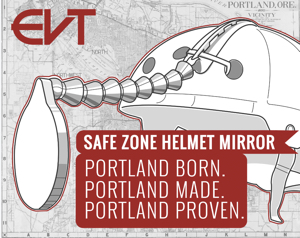Greg Spencer is a writer and editor who volunteers with the local chapter of Families for Safe Streets.
Eighty crosswalks and 45 light-rail stations made safer. That’s how Darla Sturdy sums up her proudest accomplishment to date.
Sturdy, a Gresham mother and member of Families for Safe Streets Oregon and SW Washington, never imagined a second life as a transportation engineer, much less as a lobbyist. But this is the work she threw herself into after her boy was run over and killed by a MAX light rail train.
Sturdy began collecting data on MAX’s safety record, finding 505 crashes (including 108 with people on foot or bikes) between 1994 and 2006.
The evening of June 23, 2003, Aaron Wagner-Sturdy, age 16, was heading home from a church youth group meeting on his bicycle. He pedaled westbound next to the MAX tracks at Gresham City Hall Station, and turned left to get across the tracks by using the pedestrian crossing. He meant to cross behind an eastbound train that was just pulling out. However, a second train going in the opposite direction was coming in at about 35 mph and Aaron didn’t spot it in time. The driver honked but it was too late. Aaron’s bike left a 6-8-foot skid mark, according to the police report.
For months after her son’s death, Sturdy was in a daze. She lost weight, and had to quit her job as general manager of the Spa Outlet. “I lost who I was,” Sturdy says. “It’s kind of like when you lose a child, you lose you, too. And your family loses you, because you went with him.”
In her grief, she started taking daily drives from her home, to the MAX station, to the cemetery where Aaron was buried — trying to make sense of it. At the MAX station, she watched trains coming in and out and saw several close calls with people crossing the tracks. It settled in her mind that the crossings were unsafe. “It took me about three years, but I finally realized why God put me here.”
Looking out for each other
Sturdy knew she could never bring back her own boy. But she could help other families avoid a similar fate. Having grown up in the small town of Milton-Freewater, Sturdy saw it as her duty. “In small towns, people look out for each other,” she said.
“Saving lives is number one to me and I want to make sure it is to them.”
— Darla Sturdy
TriMet laid the MAX lines in Gresham in the eighties, when the area was much less developed. Although a few newer MAX stations on Portland’s west side had gated crossings for walkers, most didn’t, certainly not the legacy stations in Gresham, and by then Gresham had grown into a bustling suburb with schools, homes and businesses right next to the tracks.
Sturdy began collecting data on MAX’s safety record, finding 505 crashes (including 108 with people on foot or bikes) between 1994 and 2006. She compiled photos of unsafe crossings, including one in Gresham that lied just 25 feet from a public school. TriMet’s own internal guidelines called for protective gates for crossings within 600 feet of schools.
Sturdy took her growing folder of evidence to the Oregon State Capitol and began working there every Wednesday and Friday, meeting 12 to 15 legislators each visit to get support for a bill she dubbed “Aaron’s Bridge to Safety.” All the while, she pulled full shifts at the Spa Outlet on weekends to fulfill her 40-hour work week.
It was no easy fight. After she’d collected the needed signatures in the House, the chairwoman of the transport committee refused to give the bill a hearing. So she introduced the bill in the Senate: wash, rinse, repeat. She got it through the Senate, and with that momentum she conquered the House, as well.
In 2007, the governor signed Senate Bill 829 into law, requiring TriMet to submit to an independent safety review of nearly 80 of its sidewalks. It took years of more lobbying– and the death of another person at the same Gresham City Hall crossing — but finally the study’s recommendations were put into force. TriMet started carrying out the improvements in 2009, and they were at last finished in 2017 — 45 stations and 80 sidewalks made safer thanks to the tireless efforts of one angry mother.
Taking it to Tigard
These days, Sturdy continues to attend occasional TriMet board meetings with David Sale, a fellow member of Families for Safe Streets who also lost a child in a public transit crash. Sturdy wants to build on her light-rail work, and ensure that the planned extension of the MAX to Tigard includes safe bike and foot crossings. “I’m trying to be part of that planning to make it safe in the beginning instead of years later,” Sturdy says. “Saving lives is number one to me and I want to make sure it is to them.”
— Greg Spencer
Never miss a story. Sign-up for the daily BP Headlines email.
BikePortland needs your support.
The post Son’s death sparks crusade for safer light rail crossings appeared first on BikePortland.org.
from Latest headlines from BikePortland https://ift.tt/2NF6lyc




No comments:
Post a Comment